Blank L., Tarquin A. Engineering Economy (McGraw-Hill Series in Industrial Engineering and Management)
Подождите немного. Документ загружается.

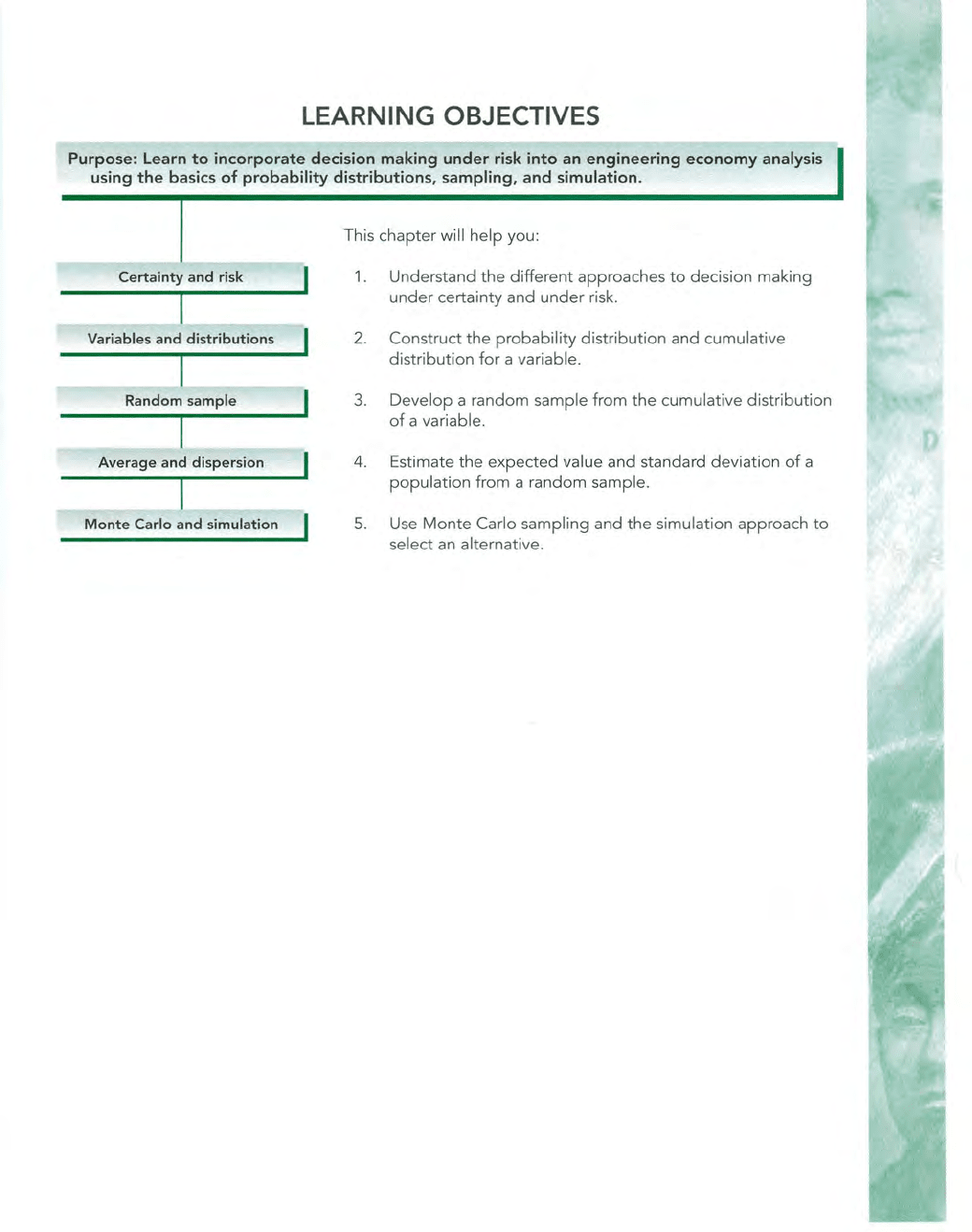
LEARNING OBJECTIVES
Purpose: Learn
to
incorporate decision making under risk into an engineering economy analysis
using
the
basics
of
probability distributions. sampling. and simulation.
Certainty and risk
Va
ri
ables and distributions
Random
sample
Average and dispersion
Monte
Carlo and simulation
This ch
ap
ter will help you:
1.
Understand
the
different approaches
to
decision making
under
certainty and
und
er
ri
sk.
2.
Construct
the
probab
ili
ty
distri
bution
and cumulative
distribution
for
a variable.
3.
Develop
a
random
samp
le
from
th
e
cu
mulative distri
bution
of
a
va
riabl
e.
4.
Es
tim
ate the
ex
pected value a
nd
standard deviation of a
popu
lation from a r
ando
m sampl
e.
5.
Use
Monte
Ca
rl
o sampling and the simulation approach
to
select an alternative.
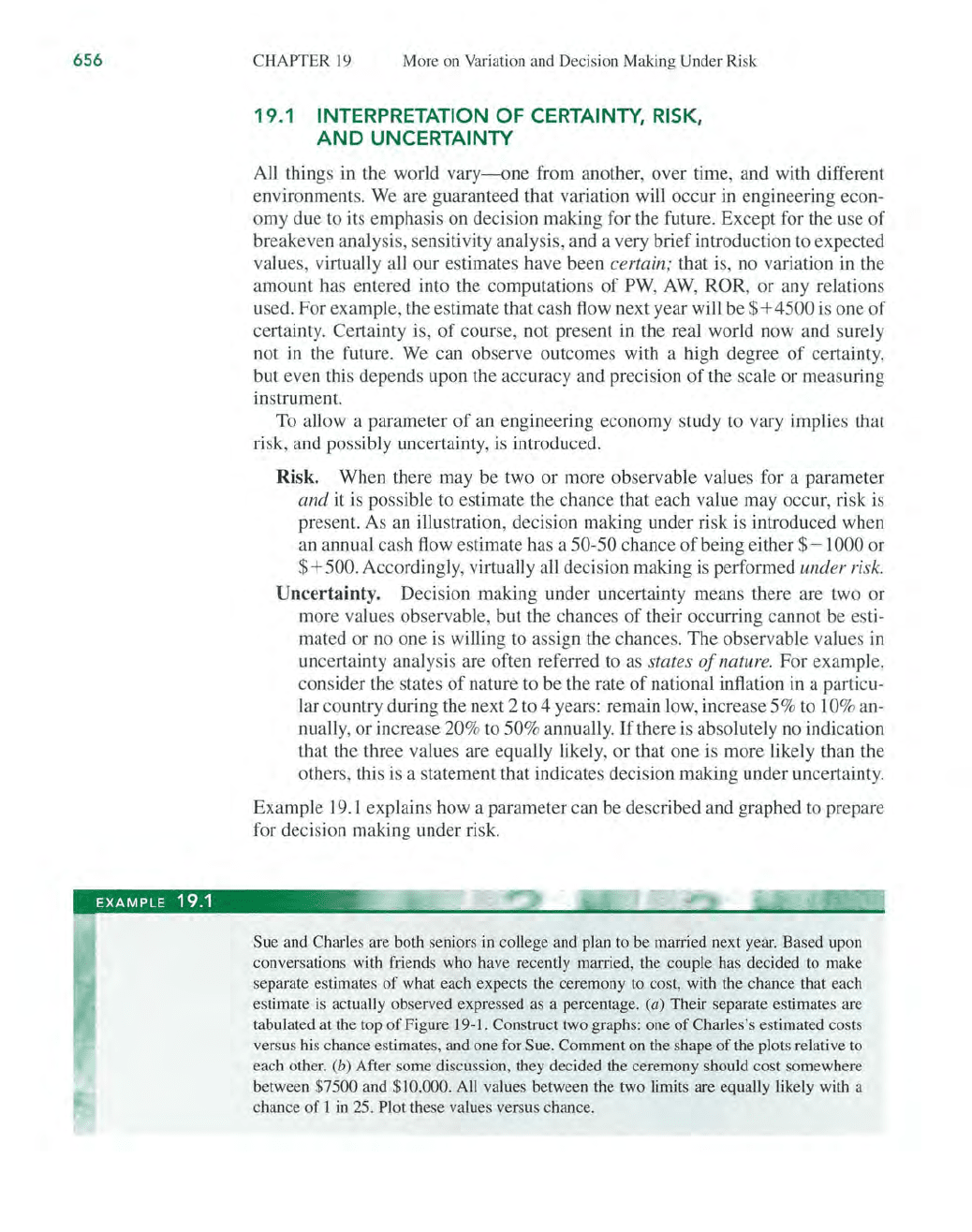
656
EXAMPLE 19.1
CHAPTER
19
More
on
Variation and Decision Making Under Risk
19.1 INTERPRETATION
OF
CERTAINTY,
RISK,
AND
UNCERTAINTY
All things in the world vary---one from another, over time, and with different
environments. We are guaranteed that variation will occur in engineering econ-
omy due to its emphasis on decision
making for the future. Except for the use
of
breakeven analysis, sensitivity analysis, and a very brief introduction to expected
values, virtually all our estimates have been
certain; that is, no variation in the
amount has entered into the computations
of
PW, A
W,
ROR,
or
any relations
used. For example, the estimate that cash flow next year will be
$+4500
is one
of
certainty. Certainty is,
of
course, not present
in
the real world now and surely
not in the future.
We
can observe outcomes with a high degree
of
certainty,
but even this depends upon the accuracy and precision
of
the scale or measuring
instrument.
To allow a parameter
of
an engineering economy study
to
vary implies that
risk, and possibly uncertainty, is introduced.
Risk. When there may be two or more observable values for a parameter
and it
is
possible to estimate the chance that each value may occur, risk is
present. As an illustration, decision
making under risk is introduced when
an annual cash flow estimate has a
50-50 chance
of
being either
$-1000
or
$ +
500. Accordingly, virtually all decision making is performed under risk.
Uncertainty. Decision making under uncertainty means there are two or
more values observable, but the chances
of
their occurring cannot be esti-
mated or no one is willing to assign the chances. The observable values in
uncertainty analysis are often referred to as
states
of
nature. For example,
consider the states
of
nature to be the rate
of
national inflation in a particu-
lar country during the next 2 to 4 years: remain low, increase 5% to
10% an-
nually,
or
increase 20% to 50% annually.
If
there is absolutely no indication
that the three values are equally likely, or that one
is
more likely than the
others, this is a statement that indicates decision
making under uncertainty.
Example
19.1
explains how a parameter can be described and graphed to prepare
for decision making under risk.
Sue and Charles are both seniors in college and plan
to
be married next year. Based upon
conversations with friends who have recently married, the couple has decided
to
make
separate estimates
of
what each expects the ceremony to cost, with the chance that each
estimate
is
actually observed expressed
as
a percentage. (a) Their separate estimates are
tabulated at the top
of
Figure 19-1. Construct two graphs: one
of
Charles's estimated costs
versus his chance estimates, and one for Sue. Comment on the shape
of
the plots relative
to
each other. (b) After some discussion, they decided the ceremony should cost somewhere
between
$7500 and $10,000.
All
values between the two limits are equaUy likely with a
chance
of
I
in
25. Plot these values versus chance.

SECTION 19.1
Interpretation
of
Certa
in
ty, Risk, and U
nc
erta
in
ty
657
Charles
Sue
Estimated Cost,
$ Chance, % Estimated Cost, $ Chance, %
3,000
65
8,000 33.3
5,000
25
10,000 33.3
10,000 10
15,000
33.3
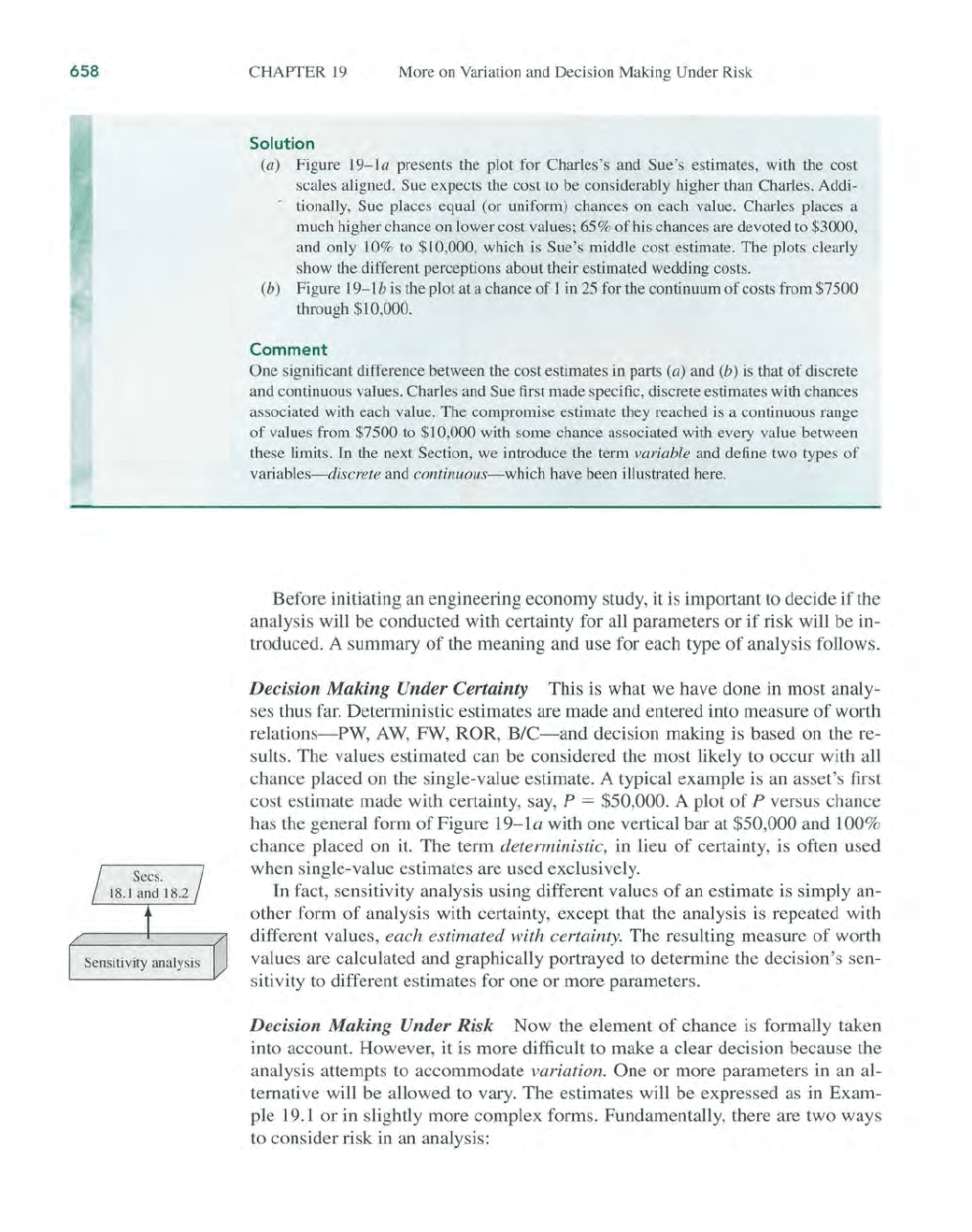
658
CHAPTER
19
More
on
Variation and Decision Making Under
Ri
sk
Solution
(a) Figure
19-1a
presents the plot for Charles's and Sue's estimates, with the cost
scales aligned. Sue expects the cost to be considerably higher than Charles. Addi-
tionally, Sue places equal (or unjform) chances
on
each value. Charles places a
much higher chance
on
lower cost values; 65% of his chances are devoted to $3000,
and only 10% to $10,000, whjch
is
Sue's mjddle cost estimate. The plots clearly
show the different perceptions about their estimated wedding costs.
(b) Figure 19-1b
is
the plot at a chance
of
1 in
25
for the continuum
of
costs from $7500
thl'ough $10,000.
Comment
One significant difference between the cost estimates in parts (a) and (b)
is
that
of
discrete
and continuous values. Charles and Sue first made specific, discrete estimates with chances
associated w
ith
each value. The compromise estimate they reached is a continuous range
of
values from $7500 to $10,000 with some chance associated with every value between
these limits. In the next Section, we introduce the term
variable and define two types
of
variables-discrete and continuous
-w
hich have been illustrated here.
Before initiating
an
engineering economy study, it
is
important
to
decide if the
analysis will be conducted with certainty for all parameters or if risk will be in-
troduced. A summary
of
the meaning and use for each type
of
analysis follows.
Decision Making Under Certainty This is what we have done in most analy-
ses thus
far.
Deterministic estimates are made and entered into measure
of
worth
relations-PW
,
AW
, FW, ROR,
B/C-and
decision making is based on the re-
sults. The values estimated can be considered the most likely to occur with all
chance placed on the single-value estimate. A typical example
is
an
asset's
fir
st
cost estimate made with certainty, say,
P = $50,000. A plot
of
P versus chance
has the general form
of
Figure
19-1a
with one vertical bar at $50,000 and 100%
chance placed on
it.
The term deterministic,
in
lieu
of
certainty, is often used
when single-value estimates are used exclusively.
In fact, sensitivity analysis using different values
of
an estimate is simply an-
other form
of
analysis with certainty, except that the analysis is repeated with
different values,
each estimated with certainty. The resulting measure
of
worth
values are calculated and graphically portrayed
to
determine the decision's sen-
sitivity
to
different estimates for one or more parameters.
Decision Making Under
Risk
Now the element
of
chance
is
formally taken
into account. However, it is more difficult
to
make a clear decision because the
analysis attempts
to
accommodate variation. One or more parameters
in
an
al-
ternative will be allowed to vary. The estimates will be expressed
as
in
Exam-
ple
19
.1 or
in
shghtly more complex forms. Fundamentally, there are two ways
to consider risk
in
an
analysis:
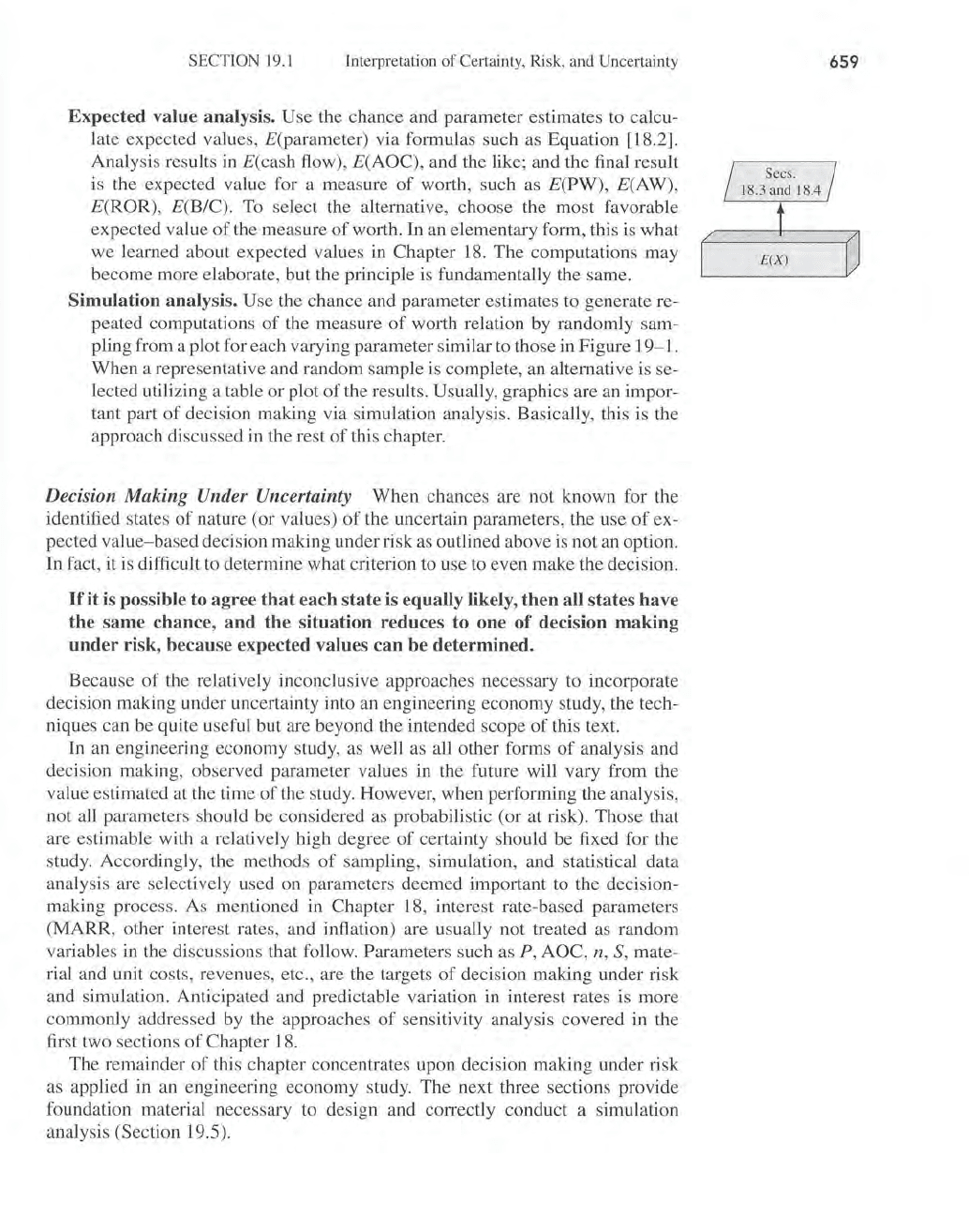
SECTION
19.1
Interpretation
of
Certainty, Risk, and Uncertainty
Expected value analysis. Use the chance and parameter estimates
to
calcu-
late expected values, E(parameter) via formulas such
as
Equation [18.2].
Analysis results
in
E(cash flow), E(AOC), and the like; and the final result
is the expected value for a measure
of
worth, such
as
E(PW), E(AW),
E(ROR), E(B/C).
To
select the alternative, choose the most favorable
expected value
of
the measure
of
worth. In an elementary form, this is what
we learned about expected values in Chapter
18
. The computations may
become more elaborate, but the principle is fundamentally the same.
Simulation analysis.
Use the chance and parameter estimates
to
generate re-
peated computations
of
the measure
of
worth relation by randomly sam-
pling from a plot for each varying parameter similar
to
those in Figure 19-1.
When a representative and random sample is complete, an alternative
is
se-
lected utilizing a table or plot
of
the results. Usually, graphics are an impor-
tant part of decision making via simulation analysis. Basically, this is the
approach discussed
in
the rest
of
this chapter.
Decision Making Under Uncertainty When chances are not known for the
identified states
of
nature (or values)
of
the uncertain parameters, the use
of
ex-
pected value- based decision making under risk
as
outlined above is not an option.
In fact, it is difficult
to
determine what criterion
to
use to even make the decision.
If
it
is possible to
agree
that
each
state
is equally likely,
then
all states
have
the
same
chance,
and
the
situation reduces to one
of
decision
making
under
risk, because expected values
can
be
determined.
Because
of
th
e relatively inconclusive approaches necessary to incorporate
decision making under uncertainty into an engineering economy study, the tech-
niques can be quite useful but are beyond the intended scope
of
this text.
In
an
engineering economy study,
as
well
as
all other forms
of
analysis and
decision making, observed parameter values in the future will vary from the
value estimated at the time
of
the study. However, when performing the anal ysis,
not
all
parameters should be considered
as
probabilistic (or at risk). Those that
are estimable with a relatively high degree
of
certainty should be fixed for the
study. Accordingly, the methods
of
sampling, simulation, and statistical data
analysis are selectively used on parameters deemed important to the decision-
making process.
As
mentioned in Chapter
18
, interest rate-based parameters
(MARR, other interest rates, and inflation) are usually not treated
as
random
variables in the discussions that follow.
Parameters such
as
P, AOC, n,
S,
mate-
rial and unit costs, revenues, etc., are the targets
of
decision making under risk
and simulation. Anticipated and predictable variation in interest rates is more
commonly addressed
by
the approaches of sensitivity analysis covered in the
first two sections
of
Chapter
18
.
The remainder of this chapter concentrates upon decision making under risk
as
applied in
an
engineering economy study. The next three sections provide
foundation material necessary to design and correctly conduct a simulation
analysis (Section
19
.
5)
.
659
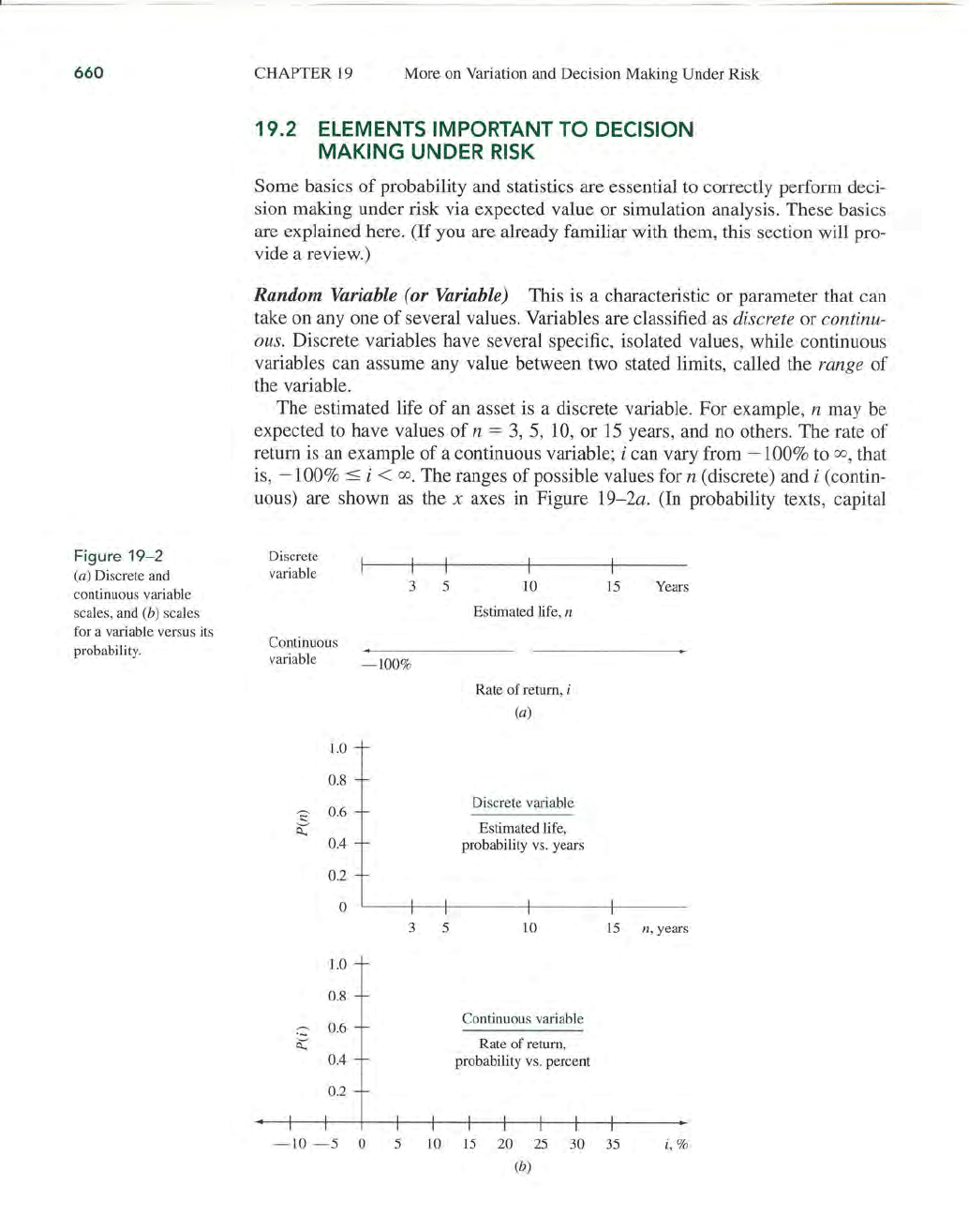
660
Figure
19-
2
Ca) Discrete and
continuous variable
scale
s,
and
Cb)
scales
for a varia
bl
e versus its
probabili
ty.
CHAPTER
19
More on Variation and Decision Making Under Risk
19.2 ELEMENTS IMPORTANT
TO
DECISION
MAKING
UNDER
RISK
Some basics
of
probability and statistics are essential to correctly perform deci-
sion making under risk via expected value or simulation analysis. These basics
are explained here.
(If
you are already familiar with them, this section will pro-
vide a review.)
Random Variable
(or
Variable) This is a characteristic or parameter that can
take
on
anyone
of
several values. Variables are classified
as
discrete or continu-
ous.
Discrete variables have several specific, isolated values, while continuous
variables can assume any value between two stated limits, called the
range of
the variable.
The estimated life
of
an
asset
is
a discrete variable. For example, n may be
expected
to
have values
of
n = 3, 5,
10,
or
15
years, and no others. The rate
of
return is an example
of
a continuous variable; i can vary from - 100%
to
00
, that
is,
- 100%
::;
i <
00
. The ranges
of
possible values for n (discrete) and i (contin-
uous) are shown
as
the x axes
in
Figure 19-2a. (In probability texts, capital
Discrete
variable
3 5
10
15 Years
Estimated life, n
Continuous
variable
- 100%
Rate
of
return, i
Ca)
1.0
0.8
0.6
Discrete variable
?
i(
Estimated life,
0.4
probability
vs.
years
0.2
0
3 5
10
15
n, years
1.0
0.8
0.6
Continuous
variable
~
Rate
of
return,
0.4
probability
vs.
percent
0.2
-
10
- 5
0 5
10
15
20
25
30
35
i, %
(b)
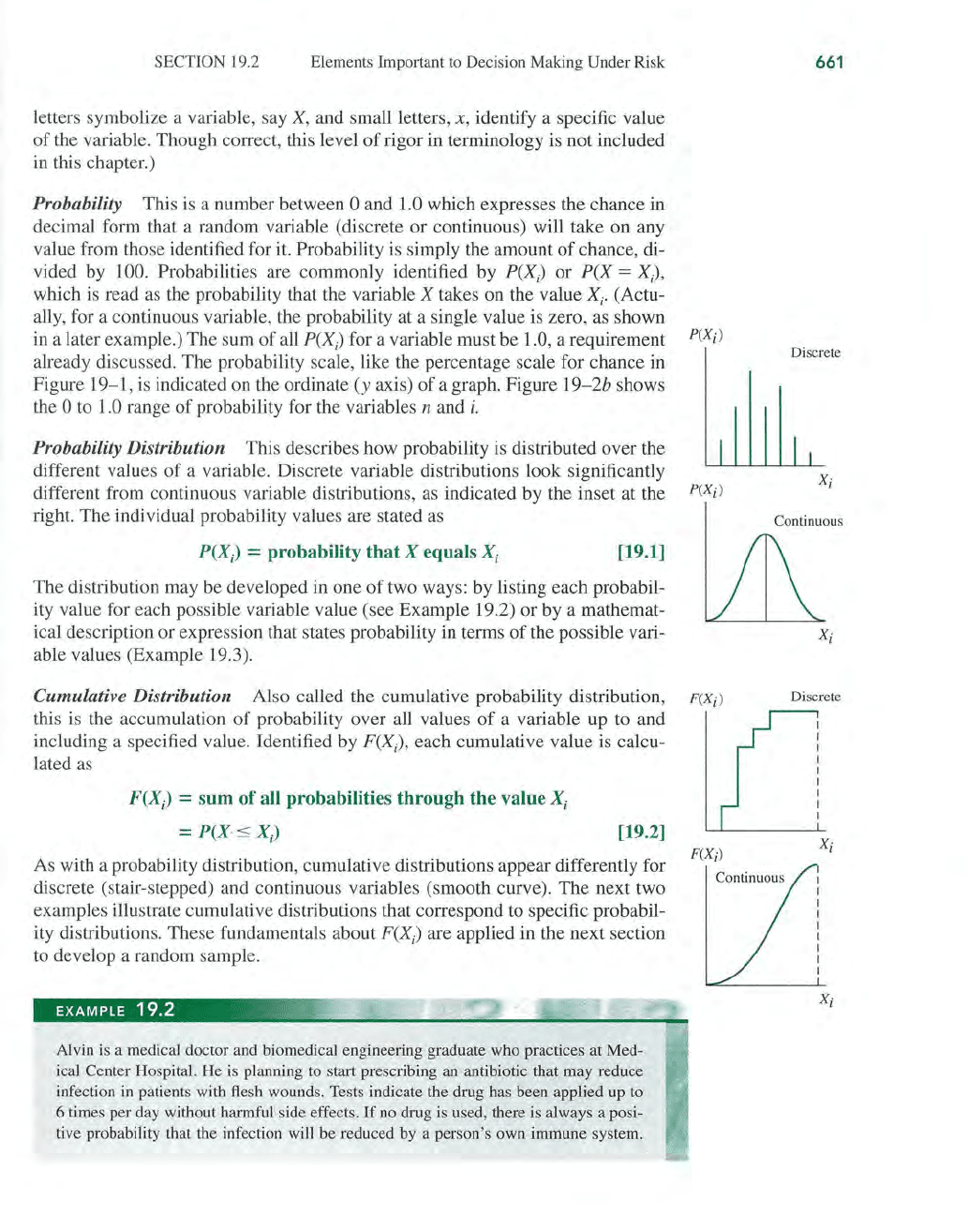
SECTION 19.2 Elements Important to Decision Making Under Risk
letters symbolize a variable, say
X,
and small letters, x, identify a specific value
of
the variable. Though correct, this level
of
rigor in terminology is not included
in this chapter.)
Probability This
is
a number between 0 and 1.0 which expresses the chance in
decimal form that a random variable (discrete or continuous) will take on any
value from those identified for
it.
Probability is simply the amount
of
chance, di-
vided by 100.
Probabilities are commonly identified by P(X
i
)
or P(X =
X),
which is read
as
the probability that the variable X takes on the value Xi' (Actu-
ally, for a continuous variable, the probability at a single value is zero,
as
shown
in a later example.) The sum
of
all
P(X)
for a variable must be 1.0, a requirement
P(Xi)
already discussed. The probability scale, like the percentage scale for chance in
Figure
19-1, is indicated on the ordinate
(y
axis)
of
a graph. Figure 19-2b shows
the
0
to
1.0 range of probability for the variables
nand
i.
661
Discrete
Probability Distribution This describes how probability is distributed over the I I I
different values
of
a variable. Discrete variable distributions look significantly
L..'--'--.L...'-----'----'-----'
-Xi
different from continuous variable distributions,
as
indicated by the inset at the
P(Xi)
right. The individual probability values are stated
as
P(X)
= probability
that
X equals
Xi
[19.1]
The distribution may be developed
in
one
of
two ways: by listing each probabil-
ity value for each possible variable value (see Example
19.2) or by a mathemat-
ical description or expression that states probability in terms
of
the possible vari-
able values (Example
19
.3).
Cumulative Distribution Also called the cumulative probability distribution,
F(Xi)
this is the accumulation
of
probability over all values
of
a variable up
to
and
including a specified value. Identified
by
F(X), each cumulative value is calcu-
lated
as
F(X)
= sum
of
all probabilities
through
the value
Xi
=
PCX-
::;
X)
[19.2]
As
with a probability distribution, cumulative distributions appear differently for
discrete (stair-stepped) and continuous variables (smooth curve). The next two
examples illustrate cumulative distributions that correspond to specific probabil-
ity distributions. These fundamentals about
F(X) are applied in the next section
to
develop a random sample.
EXAMPLE
19.2
'.
Alvin
is
a medical doctor and biomedical engineering graduate who practices at Med-
ical Center Hospital. He
is
planning to start prescribing an antibiotic that may reduce
infection
in
patients with flesh wounds. Tests indicate the drug has been applied up to
6 times per day without harmfuJ1side effects.
If
no drug is used, there is always a posi-
tive probability that the infection will be reduced by a person's own immune system.
Continuous
Discrete
X
I
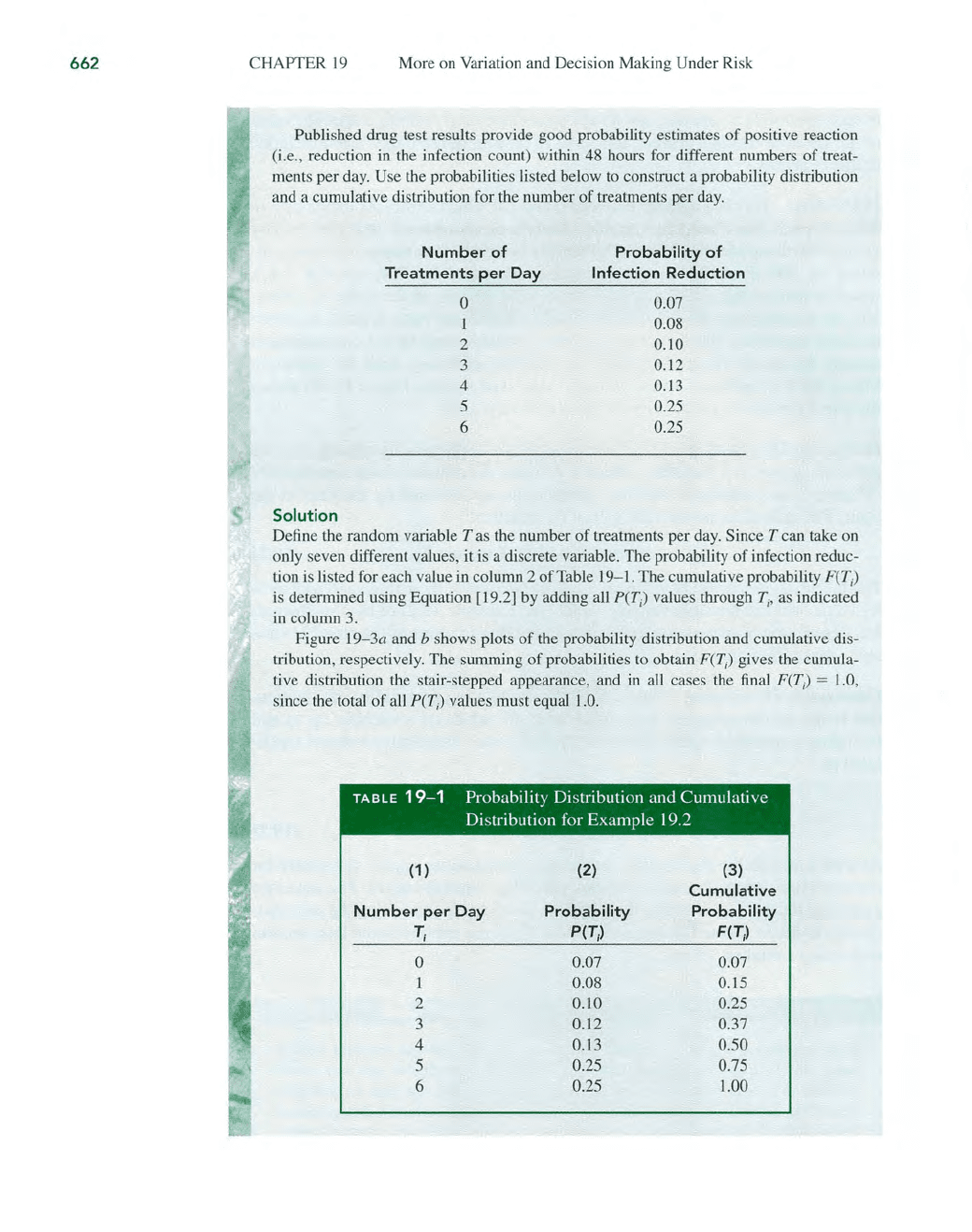
662
CHAPTER
19
More on Variation and Decision Making Under Risk
Published drug test results provide good probability estimates
of
positive reaction
(i.e., reduction in the infection count) within 48 hours for different numbers
of
treat-
ments per day.
Use the probabilities listed below to construct a probability distribution
and a cumulative distribution for the number
of
treatments per day.
Solution
Number
of
Treatments
per
Day
o
1
2
3
4
5
6
Probability
of
Infection Reduction
0.07
0.08
0.10
0.12
0.13
0.25
0.25
Define the random variable T as the number
of
treatments per day. Since T can take on
only seven different values,
it
is a discrete variable.
The
probability
of
infection reduc-
tion is listed for each value in column 2
of
Table 19-1.
The
cumulative probability
F(T)
is determined using Equation [19.2] by adding all peT) values through T
i
,
as indicated
in
column 3.
Figure
19-3a and b shows plots
of
the probability distribution and cumulative dis-
tribution, respectively. The summing
of
probabilities to obtain
F(T)
gives the cumula-
t
iv
e distribution the stair-stepped appearance, and
in
al
l cases the final
F(T)
= 1.0,
since the total
of
a
ll
peT)
values must equal l.0.
TABLE
19-1
Probability Distribution
and
Cumulative
Distribution for
Example
19
.2
(1
)
(2) (3)
Cumulative
Number
per
Day Probability Probability
T
j
P(T
j
)
F(T
j
)
0
0.07 0.07
0.08
0.
15
2 0.10 0.25
3
0.12 0.37
4 0.13 0.50
5
0.25 0.75
6
0.25 1.00
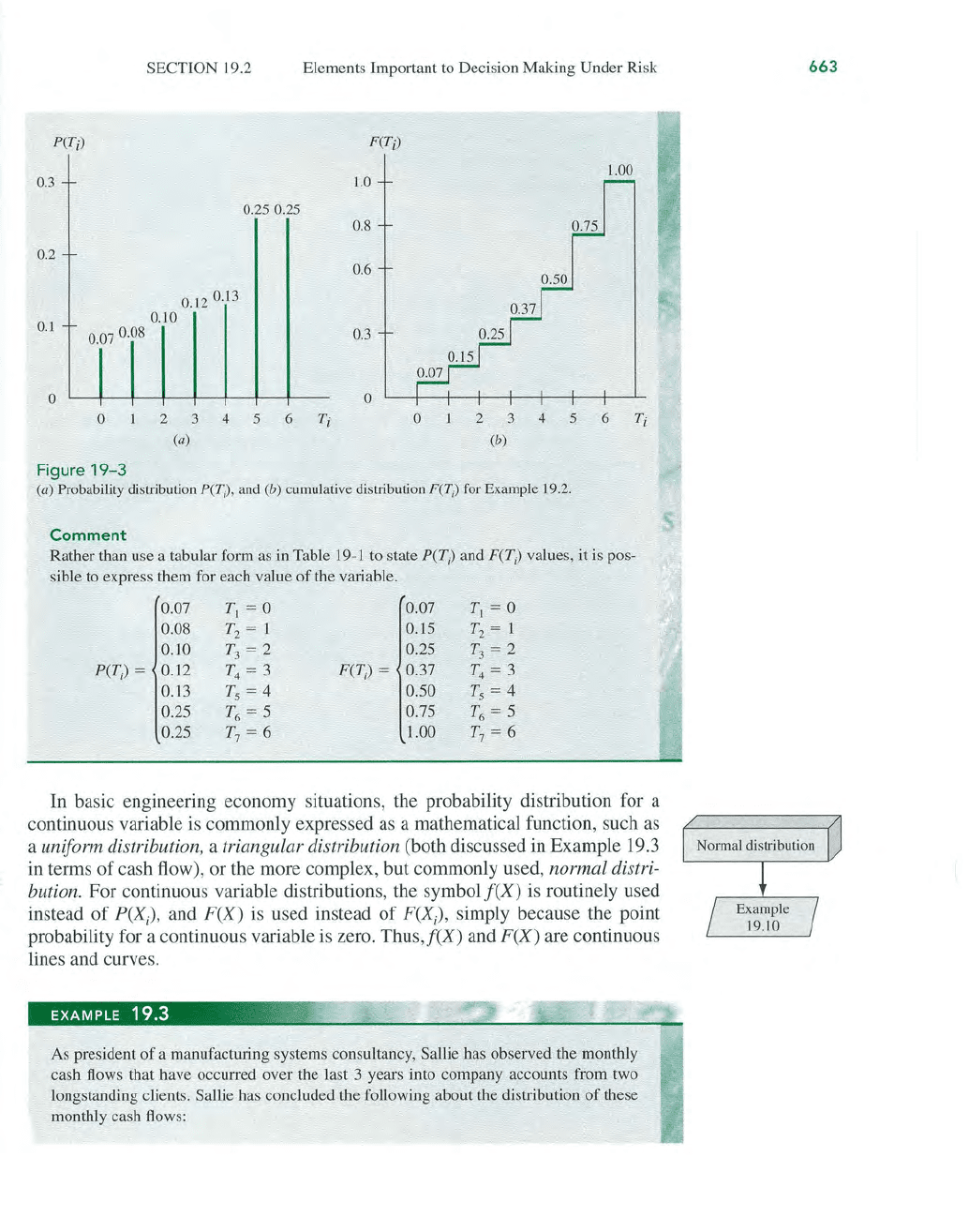
SECTION
19
.2
Elements Important
to
Decision Making Under Risk
P(Ti)
F(Ti)
1.00
0.3
1.0
0.250
.
25
0.8
0.2
0.6
0.12
0
.13
0.1
0.10
0.07 0.08
0.3
0
0
0
2 3 4
5
6
T-
/.
O
2 3
456
T'
I
(a)
(b)
Figure
19-3
(a) Probability distribution P(T;), and (b) cumulative distribution F(T,) for Example \9.2.
Comment
Rather than use a tabular form as in Table 19-1 to state peT) and F(T) values, it is pos-
sible
to
express them for each value
of
the variable.
0.07
T, = 0
0.07
T, = 0
0.08
T2
= 1
0.15
T2
= 1
0.10
T3
= 2
0.
25
T3
= 2
peT) = 0.12
T4
= 3
F(T) =
0.37
T4
= 3
0.13
Ts
= 4
0.50
Ts
= 4
0.25
T6
= 5
0.75
T6
= 5
0.25
T7
= 6
1.00
T7
= 6
In basic engineering economy situations, the probability distribution for a
continuous variable is commonly expressed
as
a mathematical function, such
as
a uniform distribution, a triangular distribution (both discussed in Example
19
.3
in terms of cash flow), or the more complex, but commonly used,
normal distri-
bution. For continuous variable distributions, the symbolf(X) is routinely used
instead
of
P(X), and F(X) is used instead
of
F(X), simply because the point
probability for a continuous variable is zero. Thus,f(X) and
F(X) are continuous
lines and curves.
EXAMPLE
19.3
S
As
president
of
a manufacturing systems consultancy, Sallie has observed the monthly
cash flows that have occurred over the last 3 years into company accounts from two
longstanding clients. Sallie has concluded the following about the distribution
of
these
monthly cash flows:
663

664
CHAPTER
19
More on Variation and Decision Making Under
Ri
sk
Client 1
Estimated low cash
flow:
$10,000
Estimated high cash
flow:
$15,000
Most likely cash flow: same for
all
values
Distribution
of
probability: uniform
Client
2
Estimated low cash flow: $20,000
Estimated high cash
flow:
$30,000
Most likely cash
flow:
$28,000
Distribution
of
probability: mode at $28,000
The mode is the most frequently observed value for a variable. Sallie assumes cash flow
to be a continuous variable referred to
as
C.
(a) Write and graph the two probability dis-
tributions and cumulative distributions for monthly cash
flow,
and (b) determine the
probability that monthly cash flow
is
no more than $12,000 for client I and no more
than
$25,000 for client
2.
Solution
All cash
flow
values are expressed
in
$1000 units.
Client
i:
monthly c
ashjlow
distribution
(a) The distribution
of
cash flows for client 1, identified by the variable C
I
,
follows
the uniform distribution. Probability and cumulative probability take the follow-
ing general forms.
fCCI)
=
---'-
--
high - low
value - low
FCC
I
)
=
----
high - low
low value
$ c
l
$ high value
[19.3]
low value $ c
l
$ high value
[19.4]
For client 1, monthly cash
flow
is
uniformly distributed with L = $10, H = $15,
and $10
$ C
I
$ $15. Figure 19-4
is
a plot
of
fCC
I)
and
FCC
I
)
from Equa-
tions [19.3] and [19.4].
